Written by: Stoo
Date posted: May 2, 2013
If you’re new to the world of retro gaming on the PC one of the first things you’ll find is that the older games aren’t necessarily too happy about running on modern machines. In fact, attempting to fire up your favourite adventure games of yesteryear on your modern gaming rig or the hideously underpowered laptop your office gave you for ‘work’ is likely to meet with limited success.
As ever, brainy internet people have come to the rescue, and getting old games to run on modern Windows systems is now a lot easier than it used to be. Here’s a brief guide to some of the things you’ll find useful in your quest to get your old games up and running again.
DOSBox
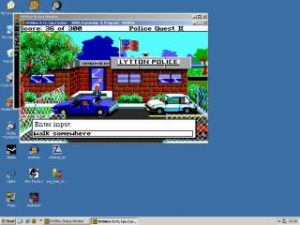 When we first started this site, we used to have to add the caveat “God knows how you’ll get this running under Windows” to some of our reviews – or outline the great lengths we, as massive nerds, went to in order to get a DOS game working for review. Frankly, it’s a relief that more often than not our “Requirements” section for most DOS titles consists of two words: Use DOSBox.
When we first started this site, we used to have to add the caveat “God knows how you’ll get this running under Windows” to some of our reviews – or outline the great lengths we, as massive nerds, went to in order to get a DOS game working for review. Frankly, it’s a relief that more often than not our “Requirements” section for most DOS titles consists of two words: Use DOSBox.
If you remember the good old/bad old (delete as appropriate) days of MS-DOS then getting games up and running should be quite straightforward. It’s normally a good idea to create a folder (in Windows, if you like) for all of your oldies (keeping each game in a separate subfolder, of course). Then, in DOSBox itself, you need to ‘mount’ that folder to tell DOSBox you want it to recognise that as your hard drive. Once that’s done, you’re away, and you could almost be back in 1994 again.
If, on the other hand, you were doing something else in 1994 (or, heaven forbid, you weren’t even born then) you might need a bit more help. But it’s still easy, I promise. Go to the DOSBox website for a quick-start tutorial, frequently asked questions – oh, and to download the application itself, of course.
Use it for: Most DOS games – it’s a great allrounder. It was designed with games in mind, and there are plenty of tweaks for you to get games running satisfactorily. It can even cope with CD games, too.
Any negatives? If your PC is old and slow, you might have performance issues with later 3D dos games (like Doom or Descent).
ScummVM
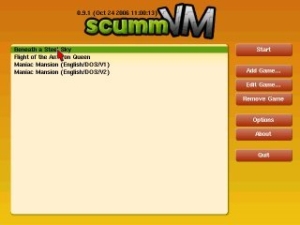 Adventure game fans might also find this useful. Taking its name from the engine that was used to create Maniac Mansion and other LucasArts adventures, ScummVM was originally designed to support these games, but over time the list of compatible games has grown to include others, including some titles by Sierra and Revolution Software (most notably Broken Sword).
Adventure game fans might also find this useful. Taking its name from the engine that was used to create Maniac Mansion and other LucasArts adventures, ScummVM was originally designed to support these games, but over time the list of compatible games has grown to include others, including some titles by Sierra and Revolution Software (most notably Broken Sword).
Setting games up to run in ScummVM can be a bit fiddly at first. You need to copy the whole lot, or a specified set of files, to your hard drive before it’ll work. Once you’ve got them installed though, it’s just a case of selecting them from the menu – no typing required. And it’s possible too that you’ll have a more positive experience than if you’d just stuck with DOSBox. On an old PC, things are a lot quicker, and you can spruce up the graphics of your blocky VGA classics, scaling things up to make them look a bit sharper – just like your favourite SNES or Megadrive emulators.
Go here for the download, guidance and more information.
Use it for: Games that are supported by ScummVM. They’ll work in DOSBox, but ScummVM might be a better bet, especially if you have an older machine.
Any negatives? A limited number of games are supported.
Windows 98
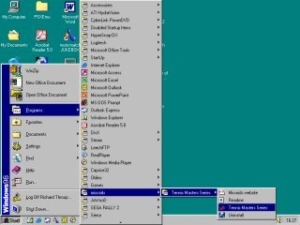 The above two options focus on MS-DOS oldies, but games written for Windows 95 or 98 can also sometimes be have problems with newer versions of Microsoft’s OS. This can be especially true if you’re running 64 bit Windows. Unfortunately there is as yet no convenient one-stop solution like DOSBox. So perversely, despite being seemingly closer to modern games than the DOS oldies, these ones can potentially be harder to run.
The above two options focus on MS-DOS oldies, but games written for Windows 95 or 98 can also sometimes be have problems with newer versions of Microsoft’s OS. This can be especially true if you’re running 64 bit Windows. Unfortunately there is as yet no convenient one-stop solution like DOSBox. So perversely, despite being seemingly closer to modern games than the DOS oldies, these ones can potentially be harder to run.
There are some techy options you could try, like Virtualisation. Or you might find a patch to make it compatible. But for the committed retro-gamer, there’s sometimes no alternative to the simple option: having a second machine set up with Win 98 to eradicate all XP and Vista related problems.
Use it for: Anything that’s fussy and released for Windows between 1995 and 2002.
Any negatives? Your girlfriend/flatmates/friends will think you’re a loser.
Source Ports
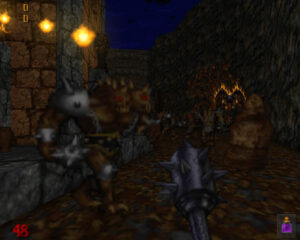 Occasionally developers will release the source code for one of their games into the public domain. Talented fans will then set about modifying the game to run natively on modern Windows systems. Even better, they’ll usually add improved graphics, taking advantage of more powerful modern hardware.
Occasionally developers will release the source code for one of their games into the public domain. Talented fans will then set about modifying the game to run natively on modern Windows systems. Even better, they’ll usually add improved graphics, taking advantage of more powerful modern hardware.
Note: the whole game isn’t being given away here, just an updated version of the engine. You’ll still need your own copy to provide game data like sprites, sounds, level maps etc.
Use it for: Anything you can, really.
Any negatives? Only applies to a relatively small number of games – if any we write about has a port available, we’ll let you know.
ReplacementDocs
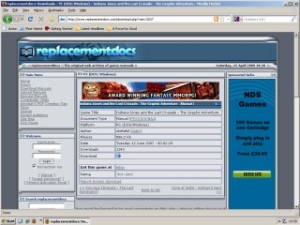 Remember game manuals? They’ve become a bit of a lost art in recent years, replaced by in-game tutorials and quick-reference control summaries. However, for some older games, manuals are essential, whether it’s because of old-school copy protection or that you’re just playing a complicated old game that uses a bizarre system of symbols and icons on its menu system and you need to know what the hell it all means.
Remember game manuals? They’ve become a bit of a lost art in recent years, replaced by in-game tutorials and quick-reference control summaries. However, for some older games, manuals are essential, whether it’s because of old-school copy protection or that you’re just playing a complicated old game that uses a bizarre system of symbols and icons on its menu system and you need to know what the hell it all means.
If you’ve bought a ‘CD only’ oldie from eBay, or grabbed an oldie from an abandonware site only to find you don’t know what’s going on, then Replacementdocs is invaluable. The list of manuals isn’t exhaustive, but it’s pretty damn close. Go to www.replacementdocs.com to have a look at what they’ve got.
Use it for: When you’re trying to play Police Quest and you keep dying because you haven’t read the manual.
Any negatives? They don’t have everything. And are there really so many people who’ve “lost” manuals for their XBox games?


 Posts
Posts